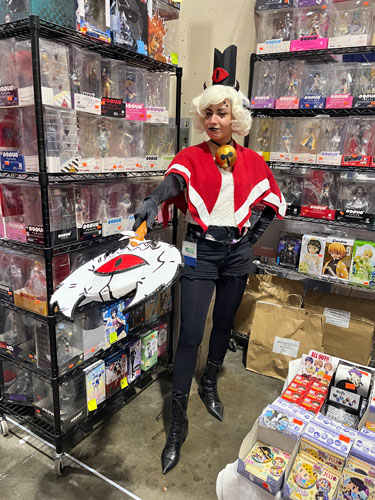
Top 10 Anime Betrayals, But I’m Still Smiling
- Episodes : 11
- Genre : Harem, Comedy, Drama
- Airing Date : Apr. 2017 – June 2017
- Studios : A-1 Pictures
Contains Spoilers
Saenai Heroine no Sodatekata ♭ (Saekano: How to Raise a Boring Girlfriend .flat) Introduction and Story (Spoilers)
Saenai Heroine no Sodatekata was a bit of a breakout series for me when it premiered in 2015. Right away, the show stood out with its smart dialogue and non-traditional setup. A young bookish otaku banding together with his professional creator pals to take his stab at making the game of his dreams. Of course, in typical harem fashion, his friends just so happen to be bishoujo who are in love with him for various reasons.
At the start of the second season, it begins where the first left off. Protagonist Tomoya Aki is on the cusp of Winter Comiket and about to release a demo of his team’s gal game dating sim, the culmination of months of hard work. Continuing forward toward the game’s release and all is not well in paradise. Tensions are high within his circle, and their successes have attracted the eyes of strong rivals who are eyeing his talented team members for themselves. Whereas the initial season was strictly ecchi-filled romantic comedy, the second season turns the drama way up.
The game’s main heroine Megumi Katou is feeling her input is being ignored and that her role on the team is vague. Kasumigaoka Utaha is graduating, and she wants a sense of closure with Tomoya, as they may be forced to part ways for good. Sawamura Eriri is in a slump upon getting recognition by her childhood crush as a talented artist, and she is having trouble finding a new goal further than that. Poor cousin Michiru, who was introduced very late last season, is further reduced to a background character, a point that the show is fine mocking, seemingly breaking the 4th wall. It’s all fun and games, until the season nears it’s finale, and then the characters and their motivations come to a head.
What We Liked About Saenai Heroine no Sodatekata ♭ (Saekano: How to Raise a Boring Girlfriend .flat)
If asked, I would say that Saekano has the most witty back and forth dialogue of any anime I’ve seen. There are very few boring scenes between Tomoya and any of the main girls. They’re all written very well and have strong characteristics. One of the brilliant things that the show does is highlight an anime trope and mock it, all while utilizing it in the same breath. The show gets away with it because it is an anime, but it still shows how good a grasp the writer has on his craft, his characters, and the setting of any given scene.
In the first episode of the season, episode 0 which aired separately, Kasumigaoka Utaha manages to trick Tomoya into returning to the girls’ hotel for a private drink. He quickly realizes that she planned to seduce him, and that he cannot escape unscathed. To Utaha’s displeasure, Katou discovers her scheme and a phone call to Aki breaks their lovey dovey alone time. The dynamic of the show is as strong as ever, and the way it can switch from romantic comedy to serious character introspective is really unique.
Discussion Time
Saenai Heroine no Sodatekata ♭ is funny 60% of the time, with the remaining percentage being split between being either serious or romantic. It usually spends each episode highlighting a specific member of his circle, either Eriri, Katou, or Utaha. While this is not a bad combination, compared to the previous season which was funny 80% of the time, it is a noticeable shift. Still, there are many laughs to be had, and what was good about the first season is even better in the second. Towards the end of the season however, things start to break down.


Saekano S2 starts off strong and keeps momentum. It doesn’t add too many new characters, but instead strengthens and refines the existing ones. It’s rewarding to see how characters you’ve grown to laugh at change and evolve beyond their stereotypical responses. That element of growth is acted out well in the shows scenes, in the dialogue and even the voice actors’ portrayals.
1. Well Written Characters
You don’t often find characters in a harem comedy with a lot of depth (trust me, I’ve seen a lot). The ones in Saekano can surprise you at times with their level of reasoning. In some other shows where similar events happen, you think that that might be the end of the story. For example, if Generic Harem MC #3549 stood up a girl, she would typically get tsundere, maybe hit him, and by the next episode it would be forgotten. Tomoya left a “date” with Katou to pursue a sulking Utaha, only for the issue to seemingly be dropped. In S2, it’s revisited as Katou still has mixed feelings about how important she is to him, as both a circle member, a friend, and possible lover. For the character who initially comes off as a boring girl (it’s in the name) it was a surprising turn in episode 8 when we saw just how much thought she actually put into everything that had transpired so far.
2. Laugh Out Loud Funny
One of the things about some harem comedies is that they either take themselves too seriously and miss completely, or the jokes they’re using have been done so many times they just aren’t worth repeating. Due to the strength of Saekano’s characters, it’s always entertaining when they butt heads. Eriri, the textbook blonde twin-tail, tsundere childhood friend, continuously contradicts herself. It’s one thing when her senpai and rival Utaha corrects her, but this season, her kouhai Hashima Izumi even gets in a few licks at her expense. Each character fits an archetype to a certain degree, and while they typically avoid falling into their tropes, some circumstances have them fulfilling their roles to a T. In another show this might not be portrayed well, but looking past the surface, it comes off as hilarious.
3. A Serious Overarching Plot
Despite seeming like it’d be the opposite, the show does focus on some serious aspects that creators face psychologically. This tends to give the show a break from the routine of jealous interactions between the girls fawning over the main character, which to be honest, happens much less infrequently than one would expect in a harem comedy. To put it in the spectrum of focusing on plot in a romantic or dramatic sense, between Spring 2017’s Eromanga Sensei and Fall 2010’s Bakuman, it leans more towards Bakuman. Both shows dealt with creators working in a professional sense, but Eromanga never escaped it’s harem comedy ways, while Bakuman felt like a serious show about evolving mangakas with light romance and comedy thrown in.
When it needs to be dramatic and serious, it sheds itself of all comedy for certain scenes. This definitely keeps the season from growing stale, as well as differentiating it from the first season. Even until the last episode when you expect everything to go right back to a reset, it takes an unexpected turn and leaves you questioning what will come next.
Whatever I say about Saekano season 2, nothing will change the fact that it is a harem comedy at its core. If you’re dead set on not watching one, then that will probably not encourage you to do otherwise. Still, even as a fan of harem comedies, there are some aspects of season 2 you may not enjoy. As said, the drama does ramp up in drastic ways in Flat. Combine that with some pacing issues that were present last time and you do have some detriments to an otherwise high quality show.
1. Love/Hate the MC
For one thing, I personally love Tomoya Aki. But that is to say that it is despite his laundry list of faults as a character. First off, he’s not indecisive like other harem leads. Instead, he has completely sworn off making decisions. He doesn’t want a girlfriend, a girl’s love, attention, or to even talk to them. He wants to ignore real world, 3D girls in favor of 2D ones (anime/manga/games). I don’t know if that’s better or worse than your typical harem protagonist who has feelings for multiple girls. It’s at least different from the type of MC that loves one girl but she acts tsundere while others keep getting in the way. But when it boils down to it, if you can’t stand someone you can’t relate to or laugh at, it’s going to be an unenjoyable show.
To me his actions are hilarious, just by the fact that someone like him simply cannot possibly exist to the extremes that he goes to. He blindfolds himself to talk to his all-female circle about anime so he doesn’t have to see them in swimsuits at one point in the series. If you can’t laugh at a man who is dead set on not being one then it’s just not going to be funny when he’s on screen, and he’s on there a lot.
2. Excessive Ecchi
I can’t imagine too many being put off by ecchi scenes in a harem comedy, but the show is otherwise a mature experience, and by mature I mean dignified. The way the show handles ecchi is to force in panty shots, below skirt angles, and cleavage zoom-ins during heavy dialogue sequences. While reading subs you miss out on a lot of this, but it still remains that an otherwise important scene is being catered to the lowest common denominator with some tastelessness. For a show that is so well crafted to be forced into resorting to scenes like that, which stand out like a sore thumb, it really does more harm than good.
3. Forced Drama Towards the End
It isn’t until episode 9 that the show drops a bit of a bombshell on fans, as well as the main character. While it fits the characters’ motivations, and even makes sense from a realistic standpoint, it does sour an otherwise light-hearted and comedic show with a somewhat dark, dramatic twist. The two most prolific professionals in Tomoya’s group have been poached by large scale producer Kosaka Akane. She has seduced them with the promise of working on Fields Chronicle, a game that in comparison is supposed to be evocative of what Final Fantasy might be to us. It’s a huge opportunity, and the girls cannot pass it up. Unfortunately, they don’t inform Tomoya that they have already left him until he approaches them to work on his sequel.
It’s a strong blow to the show, and it leaves it on a sour note. On paper, or while reading this review, it doesn’t really portray just how unexpected the turn was. The two girls had listened to Tomoya talk about his lofty dreams for their sequel based on the unprecedented success of their first game. All the while they had nodded along, without ever having any intent to rejoin him in the first place. Fans who are curious to see how he wins the two back and challenges the next rival, a rather shounen-type of development, are left disappointed. He heartbrokenly and begrudgingly accepts it. He justifies it in his mind, even though he detests it, he’s powerless to stop them. The one left to pick him up after his darkest hour is the main heroine of his game, Megumi Katou. She promises to continue with his circle and help him to make his sequel better than the original. As a fan, I’m still processing it, and with the state of anime in Japan, it begs the question of whether a conclusion will be adapted to continue it.
Honey’s Closing Statement
Overall, Saenai Heroine no Sodatekata ♭ was a better season than the first. It ends on a happy note, as we see all the characters reuniting to spy on Tomoya as he and Megumi head to school. It still feels a bit too wishy washy, however. As a fan of light hearted romantic comedies, the episode 9 betrayal still stings. Also, as a fan of bittersweet dramas, the show’s attempt at adding in comedy afterwards feels too forced. It feels like the show can’t decide what it wants to be, so it just becomes what it is.
The decision of Kasumigaoka Utaha and Sawamura Eriri was ultimately the right choice for their dreams. They had drifted apart from Tomoya Aki at the start of season one and were barely on speaking terms. It wasn’t until the chance encounter Tomoya had with Megumi Katou that he rekindled his friendship with them, and the three grew closer. At the end of the day, they were playing fiddle to his love sonnet to another girl, and it made sense for them to leave. It’s very rare for harem characters to act separate from the male MC, or to leave him altogether. The show opted for an odd 3rd option, of choosing to leave the MC, but not give up on him, which feels like an odd choice. No matter how you look at it, in a three woman race, the only one left running would win, and that’s what it seems has happened for the remaining Megumi Katou.
It feels like a lot was left unsaid either way. Everything sorts itself out, and they go their separate ways momentarily as a team, but they all remain close friends. It feels like the show stepped foot into too dark a territory, immediately stepped out, but still tracked too much darkness in to avoid getting caught. It was a wild ride and an interesting one, but it leaves you a bit perplexed about whether to laugh or feel somber. For a moment, it feels like the show could seriously turn itself into a drama, but thrusts itself back -forcefully and awkwardly- into a romantic comedy. While it is still enjoyable, it does give off a longing for what could have been. Fans of the first season must watch this, but newcomers may feel like it’s not to their liking. It’s a mixed breed, and not a dog everyone wants to bet on.
Recommended Post




